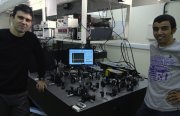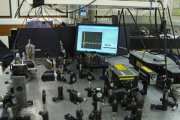Source: Optics.org
Bulky terahertz spectroscopy systems based on ultrafast lasers could be superseded by a miniature design based on a semiconductor source.
An all-semiconductor room-temperature terahertz time-domain spectrometer has been unveiled by researchers in the UK. The team believes its spectrometer is the first to use an all-semiconductor construction, which gives it both cost and size advantages over traditional designs based on ultrafast lasers. (Optics Letters 33 2125)

¡°Terahertz time-domain spectroscopy is traditionally based on Ti:Sapphire lasers, which although have excellent performance, are cost and size expensive,¡± Vasileios Apostolopoulos from the University of Southampton told optics.org. ¡°Here we are using a miniature semiconductor laser source developed by Anne Tropper¡¯s group at Southampton. It has a very high repetition rate, and the potential to produce sub-200fs pulses in the next 1 or 2 years.¡±
In its all-semiconductor approach, the team starts by fabricating a vertical external-cavity surface-emitting laser (VECSEL) capable of emitting 480 fs pulses at a wavelength of 1044 nm. The cavity includes an optical Stark semiconductor saturable absorber mirror (SESAM), which acts as the modelocking element.

The VECSEL is then used in a conventional time-domain spectroscopy set-up where it illuminates a pair of photoconductive antennae. Apostolopoulos and his colleagues report that they can detect radiation over the bandwidth 0.1 to 0.8 THz, with adequate resolution to identify water absorption lines.
¡°The same technology is used to manufacture the THz photoconductive antennas and the VECSEL components, such as the quantum well gain sample and the SESAM, commented Apostolopoulos. ¡°However, the true advantage comes from the low cost and compact form of these elements.¡±
The next step is to create a setup with 2 or 3 THz bandwidth. As a crucial first step, the team has just demonstrated a VECSEL that can produce 260 fs pulses.
¡°We also plan to study the effect of repetition rate on the signal to ratio as it is possible with VECSEL cavities to operate up to 10 GHz,¡± explained Apostolopoulos. ¡°Our long term target is to implement a compact spectrometer with a two-VECSEL pump-probe head that would lead to a miniature and very fast spectrometer, replacing both the traditional Ti:Sapphire laser and the mechanical delay line.¡±
Although Apostolopoulos and colleagues are currently focused on improving their design, they also have an eye on the potential commercial opportunity. ¡°If we deliver the expected results on performance in the next two years there is certainly a demand for a fast commercial THz spectrometer with a very small footprint and we want to target this demand,¡± he said.

